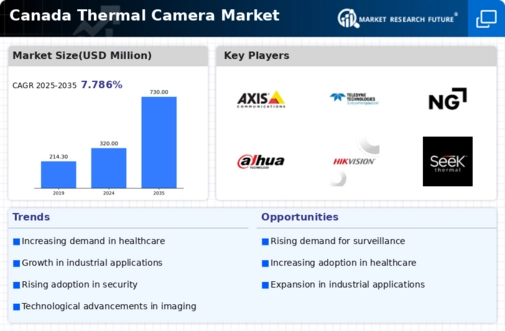Rising Demand for Energy Efficiency
Energy efficiency initiatives are significantly influencing the thermal camera market in Canada. With increasing energy costs and a growing emphasis on sustainability, businesses and homeowners are seeking innovative solutions to reduce energy consumption. Thermal cameras play a crucial role in identifying heat loss in buildings, enabling effective insulation improvements and HVAC system optimizations. The Canadian government has implemented various programs to promote energy efficiency, which further stimulates the demand for thermal cameras. It is estimated that the residential sector contributes around 25% to the thermal camera market, as homeowners utilize these devices for energy audits. This trend not only supports environmental goals but also offers potential cost savings, thereby enhancing the attractiveness of thermal cameras in the market.
Expansion of Healthcare Applications
The thermal camera market in Canada is witnessing an expansion in healthcare applications, particularly in the fields of diagnostics and patient monitoring. Thermal imaging technology is increasingly being utilized for non-invasive assessments, such as detecting fevers and monitoring blood flow. Hospitals and clinics are recognizing the benefits of thermal cameras in enhancing patient care and operational efficiency. Recent statistics suggest that the healthcare sector represents approximately 15% of the thermal camera market, reflecting a growing acceptance of this technology. As healthcare providers continue to seek innovative solutions to improve patient outcomes, the integration of thermal cameras into medical practices is likely to increase, thereby driving market growth. This trend underscores the versatility of thermal cameras beyond traditional applications, positioning them as valuable tools in the healthcare industry.
Growing Focus on Safety and Security
The thermal camera market in Canada is significantly influenced by the growing focus on safety and security across various sectors. Organizations are increasingly investing in thermal imaging technology to enhance surveillance and monitoring capabilities. This trend is particularly evident in sectors such as transportation, critical infrastructure, and public safety, where thermal cameras are employed for perimeter security and threat detection. The market data indicates that the security sector constitutes around 30% of the thermal camera market, highlighting its importance. As concerns regarding safety continue to rise, the demand for thermal cameras is expected to grow, driven by their ability to provide reliable and accurate surveillance in low-light and challenging conditions. This focus on safety and security is likely to propel the thermal camera market forward, as organizations seek to adopt advanced technologies to protect assets and ensure public safety.
Increased Adoption in Industrial Applications
The thermal camera market in Canada is experiencing a notable surge in adoption across various industrial applications. Industries such as manufacturing, oil and gas, and construction are increasingly utilizing thermal cameras for predictive maintenance, quality control, and safety inspections. This trend is driven by the need for enhanced operational efficiency and reduced downtime. According to recent data, the industrial sector accounts for approximately 40% of the thermal camera market in Canada, indicating a robust demand. The ability of thermal cameras to detect heat anomalies and prevent equipment failures is becoming indispensable, thereby propelling the growth of the thermal camera market. As industries continue to prioritize safety and efficiency, the reliance on thermal imaging technology is likely to expand further, solidifying its role in industrial applications.
Technological Innovations and Product Development
Technological innovations are a key driver of the thermal camera market in Canada, as manufacturers continuously develop advanced features to enhance performance and usability. The introduction of high-resolution sensors, improved image processing algorithms, and integration with mobile devices are transforming the capabilities of thermal cameras. These advancements not only improve the accuracy of thermal imaging but also expand the range of applications across various sectors. The market is witnessing a shift towards compact and user-friendly designs, making thermal cameras more accessible to a broader audience. It is projected that the market for advanced thermal imaging solutions will grow by approximately 20% over the next five years, driven by these technological advancements. As the demand for sophisticated thermal imaging solutions increases, the thermal camera market is likely to benefit from ongoing product development.



















Leave a Comment